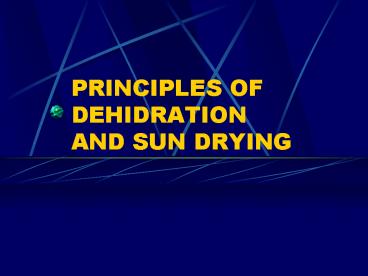PRINCIPLES OF DEHIDRATION AND SUN DRYING - PowerPoint PPT Presentation
Title:
PRINCIPLES OF DEHIDRATION AND SUN DRYING
Description:
PRINCIPLES OF DEHIDRATION AND SUN DRYING The main advantages of dehydration or sun drying over other methods of preservation include : Light weight-between 60% and ... – PowerPoint PPT presentation
Number of Views:126
Avg rating:3.0/5.0
Title: PRINCIPLES OF DEHIDRATION AND SUN DRYING
1
PRINCIPLES OF DEHIDRATION AND SUN DRYING
2
The main advantages of dehydration or sun drying
over other methods of preservation include
- Light weight-between 60 and more than 90 of
most foods is water, and most of this is removed
by dehydration. - Compactness-most dehydration product occupy less
space than original, frozen or canned material,
especially if compressed into blocks. - Ambient storage-no refrigeration is required, but
there are limitations on the maximum storage
temperature for adequate storage life. - convenience
3
The main disadvantages of dehydration or sun
drying, some of which can be overcome with newer
techniques and pre-dehydration treatments,
include
- Heat sensitivity, as all food products are heat
sensitive to some degree and can develop burnt
flavours under badly controlled drying
conditions. - Loss of volatile flavours.
- Structural changes, as the result of shrinkage
during water removal.
4
- Case hardening, which reduces rates and gives
poor quality product. - Browning as the result of non-enzymics reactions
involving concentrated reactants, and oxidation
of lipid components. - Microbial deterioration if drying rates are
initially slow, or if final moisture contents are
too high.
5
The main factors which affect the rate of drying
of a foodstuff are
- The physical and chemical properties of the
product (shape, size, composition, moisture
content). - The geometrical arrangement of the product in
relation to the heat transfer surface or medium. - The physical properties of the drying environment
(air temperature, humidity, velocity) - The characteristics of the drying equipment (heat
transfer efficiency).
6
aw and Microbial Stability
- aw, and not water content, determines the lower
limit of available water for microbial growth. - Most bacteria do not grow below aw 0,91.
- Most moulds cease to grow below aw 0,70.
- Fungi have been shown to grow in the range
0,70-0,75.
7
- Environmental factors affect the level of water
activity required for microbial growth. - The general principle which often applies is that
the less favourable the other environmental
factors (nutritional adequacy, pH, oxygen
pressure, temperature) the higher becomes the
minimum water activity at which microorganisms
can grow.
8
Methods of drying and dehydration
- Sun drying and solar drying
- Methods of dehydration
- Some of methods of dehydration suitable for
solid foods are - cabinet or tray drying
- continuous belt drying
- bin drying
- fluidized bed drying
- freeze drying
9
- Methods of dehydration suitable for liquid, pulpy
or pureed foods includes - drum drying,
- spray drying,
- foam mat drying,
- tray drying,
- freeze drying.































